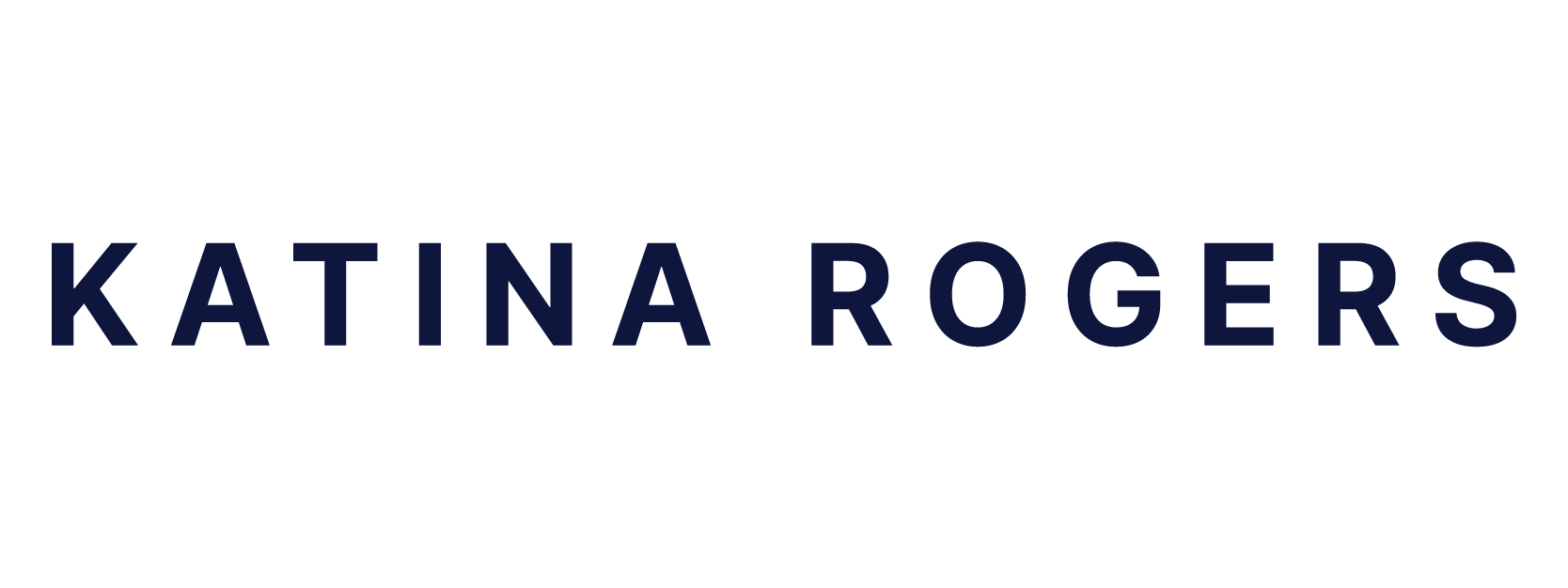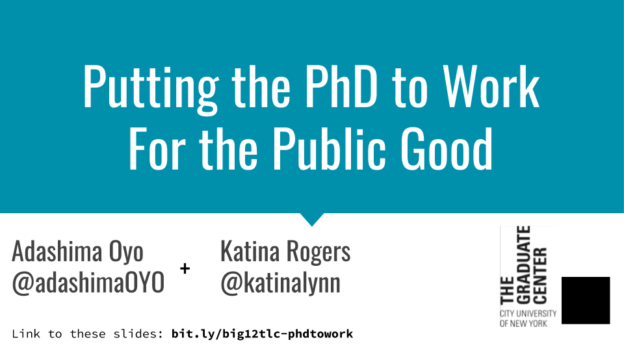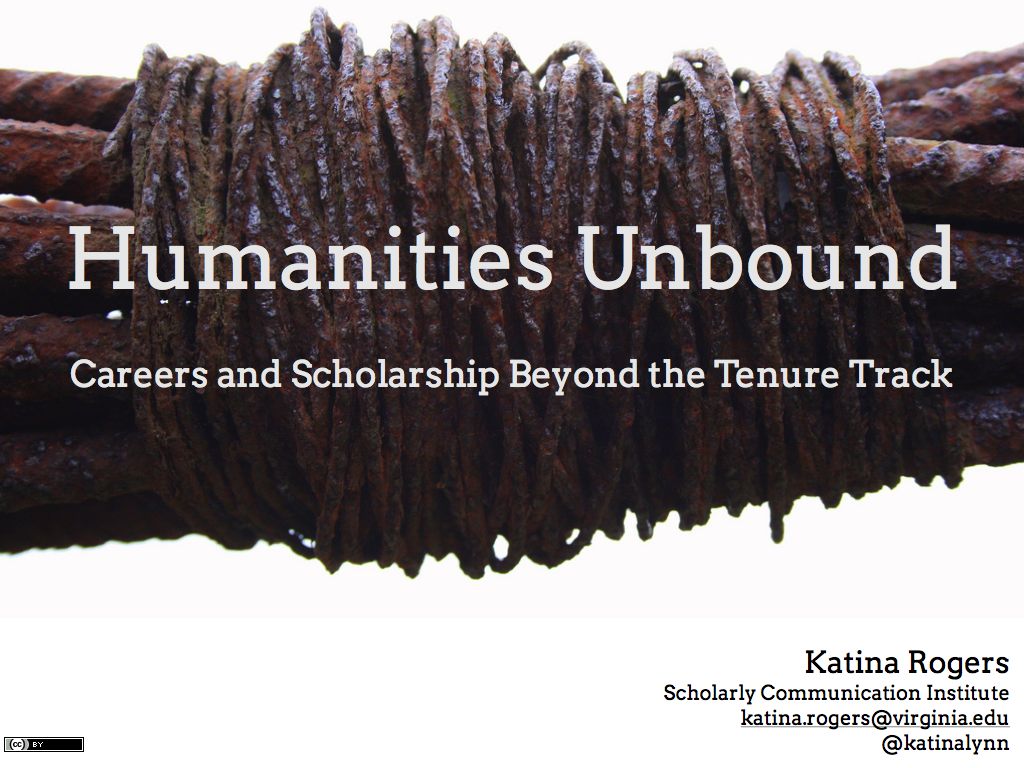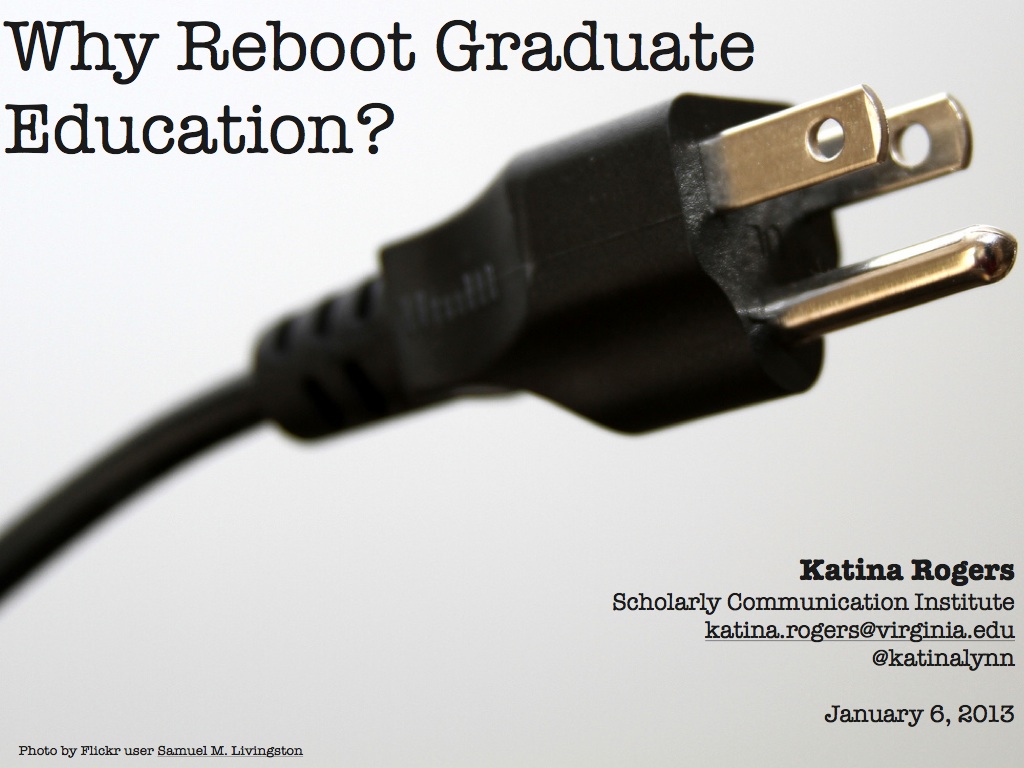The following is a position paper for an upcoming workshop on the dissertation convened by the Council of Graduate Schools (January 27-29, 2016). I’ll be speaking on a panel focusing on what new technologies enable us to do with this critical milestone in graduate study. My main argument is that while the affordances of specific technologies can be exciting, more important is the shift toward collaborative, creative, and public-facing scholarly work that today’s digital platforms allow.
UPDATE:
The full agenda and all participants’ position papers are available at http://cgsnet.org/cgs-future-dissertation-workshop.
As the capstone of doctoral training, the dissertation is the pivotal moment when graduate students synthesize and articulate their research, marking the transition from apprentice to scholar. It also serves an important professionalization and normative function: graduate students learn what is accepted as scholarly work based on the submission requirements for their dissertation and the values of their committee. If digital projects are to remain an important avenue for the articulation and public sharing of scholarly work, that work must be professionally viable for people from the outset their careers. By rethinking dissertation requirements, graduate students learn that exploratory, cutting-edge work is encouraged from day one, not something that must wait until after securing tenure. This means more than simply allowing different file formats to be submitted, however. The conversation must go beyond specific technologies to focus on the values we embrace, the methods we consider crucial, and the potential for impact that we can imagine in the dissertation process (where “we” includes all those involved in shaping the structures of graduate education).
These issues are not unique to the dissertation as a work of research. The same questions of values, methods, and impact are at the heart of the changing landscape of scholarly publishing systems, and new developments in one domain will undoubtedly affect norms and expectations in the other. With that in mind, a discussion about new opportunities for the dissertation must also touch on ways that innovative scholarship is received and recognized at later stages of a scholar’s career, including expectations set out in the tenure and promotion process. I would argue that placing greater emphasis on public engagement, collaborative work, and creativity in both dissertations and other scholarly work, while also maintaining an open stance toward technological innovation, will result in meaningful research whose reach extends far beyond the academy.
Publishing is about making knowledge public. As tautological as that statement is, the central value of making research public is sometimes lost in discussions about scholarly communication. At the heart of research and publication is the goal of bringing new insight into the body of human knowledge. This happens in different ways—sometimes the best audience to reach is small and specialized while other times it is more powerful to reach a broad, interested public. Digital tools allow us new ways of doing each. Because working in digital environments and using new tools and platforms can involve a wide range of different skill sets, such projects often involve multiple people with varied and overlapping expertise. The collaborative process of working in digital environments is not merely expedient, however; it can also have a deep influence on the nature of the work itself, resulting in a project that may be more sophisticated and complex than a series of individual projects by the same people would be. Further, digital environments allow for expansive thinking and creative ways of articulating an idea thanks to the multimodal and multimedia capabilities of current web design.
The value systems that define dissertation requirements are shaped by what we consider the values and purpose of higher education to be. This is another reason why it matters greatly that robust digital projects have the potential for meaningful impact beyond the academy. Public engagement is an essential part of understanding higher education as a public good, and as such is critical to the mission of the Futures Initiative, a program I co-direct with Cathy Davidson. Based within the Graduate Center at the City University of New York (CUNY), the Futures Initiative is part of the largest public urban university system in the United States. CUNY educates an incredibly diverse student body comprising 500,000 students across New York City’s five boroughs. Understanding education as a public good, especially in the context of a huge public university system in the heart of a thriving city that is also home to massive income inequality, means that engaging with a broader community is critical to its success.
As part of the Futures Initiative’s work, we connect not only with colleges across the CUNY system, but also with a global (though predominantly North American) community called HASTAC: the Humanities, Arts, Science, and Technology Alliance and Collaboratory. Though innovation is often thought of as something for elite and well-funded institutions, the Futures Initiative and HASTAC both see innovation happening out of necessity. Teams across the CUNY campuses have developed incredible projects (like Commons in a Box, OpenLab at City Tech, Vocat, Science Forward, and more) in part to stitch together such a diverse and geographically dispersed group of working commuter students, faculty, and staff. At the Futures Initiative, we place a strong emphasis on pedagogy, labor issues, and public engagement. Making effective use of digital tools allows us to do our best work in each of these domains and have a greater impact than we otherwise might. Understanding equity and innovation as two facets advancing a single goal allows the Futures Initiative greater clarity of purpose and approach.
Further, if we see equity and innovation as linked, rather than opposed, then it follows that recognizing a broader range of scholarly products makes it possible for scholars with varied backgrounds and skillsets to break new ground—it opens up new avenues so that scholars, departments, or institutions do not maintain the status quo, gatekeeping in ways that allow only certain kinds of people and ideas to advance. This kind of work also makes research and scholarship more accessible to different kinds of publics as people’s work is shared through different channels and platforms. Both HASTAC and the Futures Initiative sites are public, so anyone—regardless of whether or not they are affiliated with a university or any other institution—can read, contribute, and become a part of the network.
In addition to networks like these that foster communication in new ways, scholarly work itself is also changing. There is an increasing prevalence of born-digital work that pushes at the limits of traditional forms, and some of the most creative work is being done by emerging scholars on dissertations.
One of the Futures Initiative’s kick-off events in fall 2014 was a panel called What Is A Dissertation (better known on Twitter as #remixthediss), in which graduate students and recent graduates shared projects that don’t resemble the proto-monograph of most dissertations. The work by these remarkable students and recent PhDs includes the use of Tumblr and other social media to share and discuss historical photographs of black women; ethnographic work on contemporary youth created using video and the multimodal platform Scalar; the ecology of proprietary data, explored and shared using mapping visualization tools; a dissertation on comics in comic form; and more.
These students and recent graduates are doing top-notch research and sharing it in ways that make it compelling to a wide audience. Still, many of them noted that they faced resistance to their projects at some stage of the process, and found that they needed to carefully articulate the value of their projects to ensure the scholarly merit was recognized. As they found, scholars often must provide traditional materials as an additional component to their groundbreaking work, translating their projects into more familiar media. This puts an added burden on emerging scholars and acts as a disincentive from pursuing creative projects in the first place. Nevertheless, sharing work publicly and collaboratively not only benefits the public, but can also serve the individual scholars by making their work accessible.
Despite lingering fears that sharing work online will make formal publication less likely, some publishers see online engagement as an advantage and are thrilled when a work already has an audience ready and waiting. For instance, Nick Sousanis, Post-Doctoral Scholar at the University of Calgary and one of the #remixthediss panelists, had a book contract with Harvard University Press in hand before even finishing his dissertation. He was able to achieve this not only because his graphic novel Unflattening is brilliant and beautiful and innovative, but also because he had built a strong audience by sharing his work-in-progress online, thus demonstrating to the publisher that the book was marketable in a way that not all academic works are.
Other scholars have had similar experiences. Kathleen Fitzpatrick, Associate Executive Director and Director of Scholarly Communication at the Modern Language Association, shared her book Planned Obsolescence—an exploration of technology, publishing, and the academy—online for public comment. In effect she created an experimental publishing environment for her inquiry into academic publishing. The work received hundreds of thoughtful comments in a medium that allowed much more dialogue than traditional double-blind peer review. The open environment gave Fitzpatrick an opportunity to polish her work in conversation with peers, leading to a stronger final work, a positive collaborative experience, and an audience that was eager to see the final product. This deep level of interaction was possible in part because Fitzpatrick had already built an online community through countless interactions with peers. This is important to note because networks online work the same way they do in person—they must be built over time.
These are merely two examples of online engagement and the publishing of works-in-progress that led to traditional book publications. But what about more innovative, born-digital publications? New platforms like Scalar, developed at the University of Southern California under the direction of Tara McPherson, allow scholars to present research in creative, dynamic, multimodal ways that allow for incredible nuance, insight, and beauty. As one example, artist and educator Evan Bissell created a multimodal project called The Knotted Line to examine the history of incarceration, education, and labor. The exceptionally interactive result is something completely different than a traditional article on the same topic would be, even if the research were the same.
Purdue Assistant Professor and Digital Humanities Specialist Amanda Visconti’s digital dissertation, Infinite Ulysses, is another compelling example of the power of born-digital work. Combining deep literary insight with interface design, web development, community building, and best practices in user testing and analytics, Visconti has created a space for collaborative interpretation of a text. Since its launch, hundreds of readers have annotated James Joyce’s text. Further, Visconti has provided an invaluable service to the community by blogging every stage of her research, development, and defense, helping to make transparent the hurdles that other emerging scholars might anticipate when working on digital projects.
If programs begin to welcome new kinds of dissertations, they will also need to work backwards and reformulate the kinds of training that their graduate programs offer. Research methods and courses might be paired with professional development opportunities to learn skills that will allow graduate students to create the best kind of project to suit their research. They might encourage more interdisciplinary work as well as increased collaboration. Most creative projects are not the work of only one person, but incorporate the expertise of many—someone (or some team) who develops an extensible tool, a developer who customizes it for a new purpose, a designer who determines the best way to present information to a particular audience. If each of these collaborators has deep grounding in humanities methods and values, the entire project can cohere in a powerful way. To enable programs to move in that direction, there needs to be a conscious decision to start valuing collaborative, interdisciplinary work from students in the early stages of the program.
Celebrating the scholarly merit of differently-inflected, public-facing dissertation projects also means that students will be primed to succeed in more varied career paths. The skills they gain will help them to become excellent faculty members, too, who can work to further innovate the higher education landscape. Innovative projects may require specific skills—like video editing, web development, or database design—and they will undoubtedly require more generalized skills such as project management, navigating institutional hurdles, and public engagement. Fostering innovative scholarly work is a key aspect of helping students to be better prepared for multiple career possibilities. In other words, changing what constitutes a successful dissertation has the potential to change a great deal about graduate programs, from start to finish in a student’s tenure: what programs look for in prospective students, how they structure coursework and exam requirements, and what kinds of careers graduates pursue.
Importantly, expanding our interpretation of success and rigor to include a broader range of projects that lead to more and varied career opportunities also has the potential to expand access to and equity within higher education. Access to higher education (and to good quality K-12) remains highly unequal across the country, with test scores mapping not to true achievement or potential but to school district and family income level. If we continue to look for the same types of outcomes in terms of scholarly work and career paths, we are likely to perpetuate the existing system. If, instead, we celebrate different kinds of successes, we are likely to attract a greater diversity of students who want to pursue a graduate degree for more varied reasons.
Our vision for the dissertation is expanding, but much work remains. Collaborative dissertations remain rare, even though deeply creative projects may require many hands. If we want to tackle the most complex questions, we might productively think of each student’s dissertation as one aspect of a larger project, as Todd Presner describes in his notion of the “20-year dissertation“. Technologies will change, so while issues related to building new skills as well as technical affordances and limitations may seem most pressing, questions centering on the purpose and values of higher education, and for the dissertation as the capstone of a doctoral degree, are far more important. If we care about higher education as a public good, we must find ways to foster graduate students’ most creative, innovative, and engaging work.
Works Cited
Bissell, Evan et al. “The Knotted Line.” Updated 19 Aug. 2014. Web. 21 Oct. 2015. <http://knottedline.com>
Davidson, Cathy N. et al. “What Is a Dissertation? New Models, Methods, Media.” #alt-academy: Alternative Academic Careers. 30 Dec. 2014. Web. 21 Oct. 2015. <http://mediacommons.futureofthebook.org/alt-ac/pieces/what-dissertation-new-models-methods-media>
Fitzpatrick, Kathleen. Planned Obsolescence: Publishing, Technology, and the Future of the Academy. New York: NYU Press, 2011.
Presner, Todd. “Welcome to the 20-Year Dissertation.” The Chronicle of Higher Education. 25 Nov. 2013. <http://chronicle.com/article/Welcome-to-the-20-Year/143223/>
Sousanis, Nick. Unflattening. Cambridge, Mass: Harvard University Press, 2015.
Visconti, Amanda. “Infinite Ulysses.” 2015. Web. 21 Oct. 2015. <http://www.infiniteulysses.com/>




